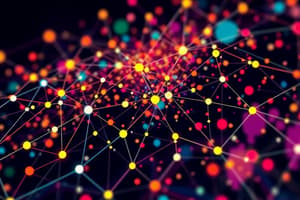Podcast
Questions and Answers
What is the definition of marginal cost?
What is the definition of marginal cost?
The cost of producing one more unit of a good or service.
The marginal cost of digital goods is almost zero.
The marginal cost of digital goods is almost zero.
True (A)
What is the formula for Metcalfe's Law?
What is the formula for Metcalfe's Law?
V = N^2
What is a one-sided network effect?
What is a one-sided network effect?
The customer experience for ordering from FoodPanda improves with shorter wait times if there are more available delivery drivers. This is an example of a two-sided network effect.
The customer experience for ordering from FoodPanda improves with shorter wait times if there are more available delivery drivers. This is an example of a two-sided network effect.
Match the following terms with their definitions:
Match the following terms with their definitions:
What are two types of switching cost?
What are two types of switching cost?
Which of these are examples of monetary switching costs? (Select all that apply)
Which of these are examples of monetary switching costs? (Select all that apply)
Two-sided markets are defined as markets in which one or several platforms enable interactions between end-users and try to get the two (or multiple) sides “on board”.
Two-sided markets are defined as markets in which one or several platforms enable interactions between end-users and try to get the two (or multiple) sides “on board”.
Which of these are examples of end-users in a two-sided market? (Select all that apply)
Which of these are examples of end-users in a two-sided market? (Select all that apply)
What is a business model?
What is a business model?
What is a digital business model?
What is a digital business model?
What are the six elements of a digital business model?
What are the six elements of a digital business model?
What are the three types of business models based on where the business operates? (Select all that apply)
What are the three types of business models based on where the business operates? (Select all that apply)
What are the five types of Revenue Strategy?
What are the five types of Revenue Strategy?
Which of these are examples of traditional sales? (Select all that apply)
Which of these are examples of traditional sales? (Select all that apply)
Versioning involves creating multiple versions of a digital product/service at minimal cost and selling them at different prices to different market segments..
Versioning involves creating multiple versions of a digital product/service at minimal cost and selling them at different prices to different market segments..
Bundling offers consumers two or more goods in one price, such as Microsoft Office Suite.
Bundling offers consumers two or more goods in one price, such as Microsoft Office Suite.
Dynamic pricing involves adjusting prices according to demand, supply and other parameters, such as Uber.
Dynamic pricing involves adjusting prices according to demand, supply and other parameters, such as Uber.
What are the two types of digital marketing channels?
What are the two types of digital marketing channels?
Which of these are examples of Organic digital marketing channels? (Select all that apply)
Which of these are examples of Organic digital marketing channels? (Select all that apply)
What are the three main competitive advantages of Foundation Models?
What are the three main competitive advantages of Foundation Models?
Foundation models are generally considered more accurate than traditional models.
Foundation models are generally considered more accurate than traditional models.
What are some of the challenges of using foundation models? (Select all that apply)
What are some of the challenges of using foundation models? (Select all that apply)
Match the following AI tools with their purpose:
Match the following AI tools with their purpose:
Flashcards
Digital Goods
Digital Goods
Goods delivered via a digital network, often with nearly zero marginal cost.
Marginal Cost
Marginal Cost
The cost to produce one additional unit of a product.
Network Effects
Network Effects
The value of a product or service increases as more users use it.
Metcalfe’s Law
Metcalfe’s Law
Signup and view all the flashcards
Direct Network Effect
Direct Network Effect
Signup and view all the flashcards
Indirect Network Effect
Indirect Network Effect
Signup and view all the flashcards
Positive Network Effects
Positive Network Effects
Signup and view all the flashcards
Negative Network Effects
Negative Network Effects
Signup and view all the flashcards
Switching Costs
Switching Costs
Signup and view all the flashcards
Monetary Costs
Monetary Costs
Signup and view all the flashcards
Time Costs
Time Costs
Signup and view all the flashcards
Emotional Costs
Emotional Costs
Signup and view all the flashcards
Platform-centric Business
Platform-centric Business
Signup and view all the flashcards
Long Tail Business Model
Long Tail Business Model
Signup and view all the flashcards
Study Notes
E-Commerce (I)
- Digital goods have nearly zero marginal cost, meaning the cost to produce the first unit is almost the entire cost of the product.
- Cost of delivery is low.
- Price variability is high.
- Marketing costs remain the same.
- Network effects increase as the number of users expands.
- Metcalfe's Law (V = N^2) quantifies network effects, where V = value and N = number of users.
- Network effects provide a strategic competitive advantage.
Direct Network Effects
- Value of a product/service increases as more users join the same side of the platform.
- Example: social media platforms become more valuable as more users join, especially influencers with large followings.
Indirect Network Effects
- Value of a product/service increases as more users join a different part of the network.
- Example: customer experience for ordering from FoodPanda improves with shorter wait times if there are more delivery drivers.
Positive and Negative Network Effects
- Positive network effects: Value increases as more people use the product/service (e.g., Facebook, Instagram).
- Negative network effects: Value decreases as more people use it (e.g., overcrowded platforms, spam and noise).
Switching Cost
- Defined as the costs incurred by customers to change a product or service.
- Types of switching costs include monetary costs (cancellation fees), time costs (researching alternatives), emotional costs (attachment to a brand), and procedural costs (data transfer).
Platform-Centric Businesses
- Multi-sided markets enable interactions between end-users.
- Examples include consumer-product/service provider, logistics side, advertiser side.
The Long Tail Business Model
- Focuses on selling a large number of niche products in small quantities, rather than a few blockbuster products.
- Reduces storage and distribution costs.
- Utilizes smart search and recommendation systems for customer product discovery.
E-Business Models
- Digital business model leverages digital technologies to improve various organizational aspects.
- Six elements of a business model that need to be aligned and reinforce each other: competitive environment, presence of the business, products and services offered, mode of business, physical, and virtual components.
- Revenue models: traditional sales, transaction fees, advertising, affiliate marketing, and subscription-based models.
- Pricing strategies: consider variable and fixed costs alongside the demand curve.
Digital Marketing
- Social media: generates sales, improves reputation, and serves customers better.
- SEO: uses organic strategies to appear in search engine results (free).
- SEM: uses paid strategies to appear in search engine results (paid).
E-Commerce (II)
- Artificial intelligence (AI) in e-commerce leads to personalized services, recommendations, and customer support.
- The YOHO case study describes an e-commerce platform for selling electronics and home appliances following a first-party selling model (1P model).
- Strength and weakness of e-commerce include high accessibility, convenience, cost efficiency, flexibility, but also issues including a lack of physical experience, delivery delays, security concerns, and limited personal interaction.
- The online-merge-offline (OMO) model combines online and offline stores.
- Porter's five forces model analyzes the threat of new entrants, bargaining power of buyers, bargaining power of suppliers, the threat of substitute products, and competitive rivalry within an industry.
CRM Software
- Enables comprehensive customer management.
- Includes partner relationship management (PRM), employee relationship management (ERM), sales force automation (SFA), and customer service capabilities.
- Categorizes customer data based on sales, marketing, and service functions (operational and analytical).
- Features, such as customer loyalty management roadmaps, show how data processing and analysis help provide valuable insights.
Customer Loyalty Management Roadmap
- Operational and analytical CRM helps resolve customer service requests by identifying and understanding customer needs.
- Analytical CRM (data warehouse) analyzes customer data and business values.
Studying That Suits You
Use AI to generate personalized quizzes and flashcards to suit your learning preferences.




